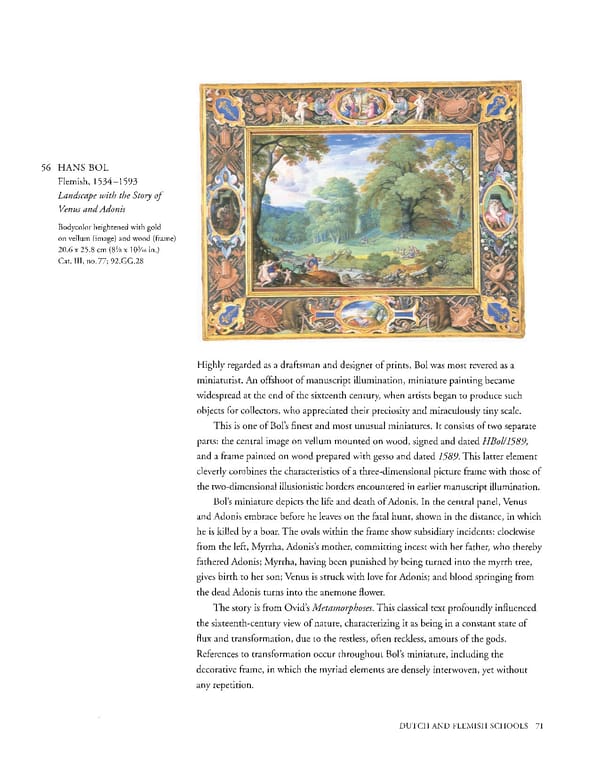56 HANS BOL Flemish, 15341593 Landscape with the Story of Venus and Adonis Bodycolor heightened with gold on vellum (image) and wood (frame) 20.6 x 25.8 cm (8 x 10 3/16 in.) Cat. Ill, no. 77; 92.GG.28 Highly regarded as a draftsman and designer of prints, Bol was most revered as a miniaturist. An offshoot of manuscript illumination, miniature painting became widespread at the end of the sixteenth century, when artists began to produce such objects for collectors, who appreciated their preciosity and miraculously tiny scale. This is one of Bol's finest and most unusual miniatures. It consists of two separate parts: the central image on vellum mounted on wood, signed and dated HBol/1589, and a frame painted on wood prepared with gesso and dated 1589 This latter element cleverly combines the characreristics of a threedimensional picture frame with those of the twodimensional illusionistic borders encountered in earlier manuscript illumination. Bol's miniature depicts the life and death of Adonis. In the central panel, Venus and Adonis embrace before he leaves on the fatal hunt, shown in the distance, in which he is killed by a boar. The ovals within the frame show subsidiary incidents: clockwise from the left, Myrrha, Adonis's mother, committing incest with her father, who thereby fathered Adonis; Myrrha, having been punished by being turned into the myrrh tree, gives birth to her son; Venus is struck with love for Adonis; and blood springing from the dead Adonis turns into the anemone flower. The story is from Ovid's Metamorphoses. This classical text profoundly influenced the sixteenthcentury view of nature, characterizing it as being in a constant state of flux and transformation, due to the restless, often reckless, amours of the gods. References to transformation occur throughout Bol's miniature, including the decorative frame, in which the myriad elements are densely interwoven, yet without any repetition. DUTCH AND FLEMISH SCHOOLS 71
 Masterpieces of the Getty Museum: Drawings Page 71 Page 73
Masterpieces of the Getty Museum: Drawings Page 71 Page 73